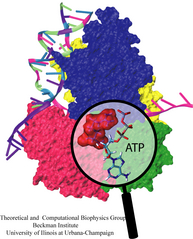Research Topics - Mechanobiology
Many cellular processes involve transformations and sustenance of mechanical forces. Forces arise as input, output and signals in cellular machines, such as ATP synthase, motor proteins, and cell surface receptors. Proteins functionally dealing with mechanical forces belong to the research subjects of the emerging new field mechanobiology. Examples among them are the giant muscle protein titin sustaining forces developed in muscle cells, the extracellular matrix fibronectin forming elastic fibrils connecting cells, mechanosensitive channels being switched on by tension applied to the cell membrane, integrins conveying mechanical signals across membrane, ankyrin amplifying weak force signals for the mechanotransduction process in hearing cells, lac repressor grappling with the regulated DNA, Fo-ATPase converting cell's electrical energy into rotation, and various ligand-receptor complexes. What is the physical mechanism underlying the mechanical functions of these proteins? Over the past decade the group has developed and applied a novel computational approach termed steered molecular dynamics to study the structure-function relationship of these mechanical proteins.
Papers
Computational investigation of DNA detection using graphene nanopores. Chaitanya Sathe, Xueqing Zou, Jean-Pierre Leburton, and Klaus Schulten. ACS Nano, 5:8842-8851, 2011.
Theoretical and computational investigation of flagellin translocation and bacterial flagellum growth. David E. Tanner, Wen Ma, Zhongzhou Chen, and Klaus Schulten. Biophysical Journal, 100:2548-2556, 2011.
Molecular origin of the hierarchical elasticity of titin: simulation, experiment and theory. Jen Hsin, Johan Strümpfer, Eric H. Lee, and Klaus Schulten. Annual Review of Biophysics, 40:187-203, 2011.
Formation of salt bridges mediates internal dimerization of myosin VI medial tail domain. HyeongJun Kim, Jen Hsin, Yanxin Liu, Paul R. Selvin, and Klaus Schulten. Structure, 18:1443-1449, 2010.
Tertiary and secondary structure elasticity of a six-Ig titin chain. Eric H. Lee, Jen Hsin, Eleonore von Castelmur, Olga Mayans, and Klaus Schulten. Biophysical Journal, 98:1085-1095, 2010.
Molecular basis of fibrin clot elasticity. Bernard Lim, Eric H. Lee, Marcos Sotomayor, and Klaus Schulten. Structure, 16:449-459, 2008.
Secondary and tertiary structure elasticity of titin Z1Z2 and a titin chain model. Eric H. Lee, Jen Hsin, Olga Mayans, and Klaus Schulten. Biophysical Journal, 93:1719-1735, 2007.
Mechanical strength of the titin Z1Z2/telethonin complex. Eric H. Lee, Mu Gao, Nikos Pinotsis, Matthias Wilmanns, and Klaus Schulten. Structure, 14:497-509, 2006.
In search of the hair-cell gating spring: Elastic properties of ankyrin and cadherin repeats. Marcos Sotomayor, David P. Corey, and Klaus Schulten. Structure, 13:669-682, 2005.
Structural insights into how the MIDAS ion stabilizes integrin binding to an RGD peptide under force. David Craig, Mu Gao, Klaus Schulten, and Viola Vogel. Structure, 12:2049-2058, 2004.
Multi-scale method for simulating protein-DNA complexes. Elizabeth Villa, Alexander Balaeff, L. Mahadevan, and Klaus Schulten. Multiscale Modeling and Simulation, 2:527-553, 2004.
Molecular dynamics study of gating in the mechanosensitive channel of small conductance MscS. Marcos Sotomayor and Klaus Schulten. Biophysical Journal, 87:3050-3065, 2004.
Structure and functional significance of mechanically unfolded fibronectin type III1 intermediates. Mu Gao, David Craig, Olivier Lequin, Iain D. Campbell, Viola Vogel, and Klaus Schulten. Proceedings of the National Academy of Sciences, USA, 100:14784-14789, 2003.
On the mechanism of ATP hydrolysis in F1-ATPase. Markus Dittrich, Shigehiko Hayashi, and Klaus Schulten. Biophysical Journal, 85:2253-2266, 2003.
Mechanical force generation by G-proteins. Ioan Kosztin, Robijn Bruinsma, Paul O'Lague, and Klaus Schulten. Proceedings of the National Academy of Sciences, USA, 99:3575-3580, 2002.
The key event in force-induced unfolding of titin's immunoglobulin domains. Hui Lu and Klaus Schulten. Biophysical Journal, 79:51-65, 2000.
Mechanical unfolding intermediates in titin modules. Piotr E. Marszalek, Hui Lu, Hongbin Li, Mariano Carrion-Vazquez, Andres F. Oberhauser, Klaus Schulten, and Julio M. Fernandez. Nature, 402:100-103, 1999.
Research Projects
- Mechanosensitive Channel MscS
- Multiscale Modeling of Gene Repression
- Mechanical Strength of the Titin/Telethonin Complex
- Molecular Basis of Hearing
- Fibronectin and Integrin
- Structure and Dynamics of Actin
- Lac Repressor - DNA Complex
- Titin
- Kinesin
- Molecular Motor Scooting along DNA
- Bacteria Swim and Tumble
- Hook and Sensor of Cells
- Cells Get Sticky With Calcium
- DNA Translocation Through Graphene Nanopores
- The Molecular Basis of Fibrin Clot Elasticity
- Flagellin Translocation and Flagellum Growth
- Stepping Mechanism of Molecular Motor Protein
- The Chain-like Elasticity of Titin




